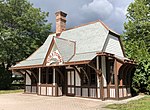Amawalk Friends Meeting House

Amawalk Friends Meeting House is located on Quaker Church Road in Yorktown Heights, New York, United States. It is a timber frame structure built in the 1830s. In 1989 it and its adjoining cemetery were listed on the National Register of Historic Places.Quakers had been active in north central Westchester County since the mid-18th century. The current meeting house was the third they built; fire destroyed both predecessors. Not only is it one of the most well-preserved and intact in the county, it is a rare surviving meeting house built by a Hicksite meeting during that schism in American Quakerism. Architecturally the meeting house shows some signs of Greek Revival influence, also unusual for Quaker buildings. The addition of a porch later in the 19th century also brought in some Victorian touches, again unusual. Its interior was renovated and the building resided when meetings were revived after a brief period of dormancy. However, many of its original furnishings remain. Taking up most of the property is the meeting's cemetery, which contains many graves of its members from the earlier years, along with that of Robert Capa, the accomplished mid-century war photographer, and his brother Cornell, although neither were members of the meeting, much less Quakers. The headstones of those graves strongly reflect Quaker burial practices, and thus the cemetery is included in the listing as a contributing resource. An architecturally sympathetic First Day School building added when meetings resumed in the 1970s is non-contributing due to its newness.
Excerpt from the Wikipedia article Amawalk Friends Meeting House (License: CC BY-SA 3.0, Authors, Images).Amawalk Friends Meeting House
Quaker Church Road,
Geographical coordinates (GPS) Address Nearby Places Show on map
Geographical coordinates (GPS)
| Latitude | Longitude |
|---|---|
| N 41.292222222222 ° | E -73.771666666667 ° |
Address
Quaker Church Road 2467
10598
New York, United States
Open on Google Maps







